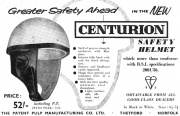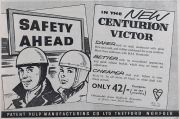Patent Pulp Manufacturing Co


of 38 York Road, King's Cross, London, N1. Telephone: North 4021 (7 lines). Works: Thetford, Norfolk. (1929)
of Mill Lane, Thetford, Norfolk. Telephone: Thetford 3209. Cables: "Pulpco, Thetford." (1947)
1879 The Patent Pulp Manufacturing Co was founded, acquiring the 1878 patent 'granted to Edward Charles Vickers and Edwin William Knowles for improvement in the treatment and application of vegetable and animal pulps or fibres for the manufacture of hollow and moulded articles in imitation of leather, earthenware or papier mâché and in the construction and arrangement for machinery to be used'.
The company flourished and increased its range of articles to over 150 items.
The main difference between papier mâché and Thetford Pulp Ware was that the pulp ware was waterproof. The chief raw material was woodpulp, jute bagging and other vegetable fibres and rags.
1929 Listed Exhibitor - British Industries Fair. Manufacturers of Pulp Ware (Wood Fibre) Articles suitable for the Household, Public Institutions, Decorative and Show Purposes. Basins, Tubs, Puff Bowls, Trays, Tradesmen's Show and Advertising Bowls, Flower Bowls, Vases, etc. (Stand No. J.115) [1]
WWII. During the Second World War supplies were restricted so secret papers were brought under escort from London to be shredded to make wartime products - mainly vulcanised fuel tanks for aircraft, tank and motorcycle helmets and containers.
The material was first cleaned by boiling with lime, then shredded in rag engines for two days to form a slurry with water. Most of the water was extracted by feeding the pulp into sieve-like formers roughly the shape of the final object. Additional water was removed with a vacuum pump and finally an hydraulic press squeezed out the remaining moisture. These blanks were placed in a drying shed for one to four weeks. When dried they felt very much like cardboard, and were stamped or embossed into their final shape by powerful cam operated machines. They were then soaked in linseed oil to make them water repellent, which turned them from grey to brown and then the decoration was added using several long and varied processes. Printed paper transfers were used for decoration or for applied advertising, and a top coat of japan or lacquer was added to make them water and acid proof.
1947 Listed Exhibitor - British Industries Fair. Manufacturers of "Thetford" Pulpware Wash-up Bowls, Basins, Pails, Baby Bath Sets, Nursery Requisites, Domestic Trays, Institution Chambers, Plates, Mugs, Bulb Bowls, Display Bowls, Miners' Hats, Pulp Mouldings and various, Vulcanises Fibre articles. (Olympia, 1st Floor, Stand No G 2069) [2]
Pulp ware manufacture ceased in the late 1950s due mainly to the introduction of polyethylene and polypropylene but also due to changes in popular taste. The company is still in operation, moulding Centurion motorcycle helmets and laminated trays with cores of paper, and so it still retains its connection with the paper products of the past. (02/08)

